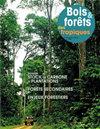Modélisation de la croissance et la production du liège en Tunisie
IF 0.6
4区 农林科学
Q3 FORESTRY
引用次数: 2
Abstract
The lack of necessary tools to estimate cork production and assess the management of cork oak forests (Quercus suber L.) in Tunisia is handicapping their development and conservation. The aims of this study were: (i) to specify the impact of first-layer bark removal on tree growth and cork production, (ii) to develop models for estimating cork oak growth and biomass on the scale of individual trees, (iii) to check the bark removal coefficients applied in Tunisia and their impact on the country's cork production. The data were collected from bark removal experiments on several sites and from two inventories conducted at different sites during two successive cork harvesting campaigns. The same experiment was conducted at three trial sites that were representative of productive cork oak forests in Tunisia, with three bark removal coefficients applied to trees of three different diameter classes. Measurements of cork thickness at breast height were taken yearly over a 12-year rotation, at the end of which the cork produced by each tree was harvested and weighed. The results obtained show that the effects of the bark removal coefficients on cork growth and thickness were non-significant, while the effects of diameter class were highly significant. The weight of the harvested cork was significantly affected both by the bark removal coefficients and the diameter class. Two models were developed for the individual tree scale for cork oak growth and biomass, with an accuracy of 96% and 93% respectively. The bark removal coefficients actually applied in Tunisia vary from 0.6 to 3.6 with an average of 1.7. Losses of cork quantities shown by the two inventories were estimated at 14%, 32% and 50% respectively for the three bark removal coefficients applied and analysed (2, 2.5 and 3).模拟突尼斯软木的增长和生产
缺乏必要的工具来估计软木产量和评估突尼斯栓皮栎林(Quercus suber L.)的管理,这阻碍了它们的发展和保护。本研究的目的是:(i)具体说明第一层树皮去除对树木生长和软木生产的影响,(ii)开发模型来估计单个树木的软木生长和生物量,(iii)检查在突尼斯应用的树皮去除系数及其对该国软木生产的影响。数据来自几个地点的树皮去除实验,以及在两次连续的软木收获活动中在不同地点进行的两次调查。在突尼斯具有代表性的生产性栓皮栎林的三个试验点进行了同样的实验,对三种不同直径等级的树木应用了三种树皮去除系数。在12年的轮换中,每年测量胸围高度的软木厚度,结束时,每棵树生产的软木被收获并称重。结果表明,树皮去除系数对软木生长和厚度的影响不显著,而直径等级的影响非常显著。采伐软木的重量受到树皮去除系数和直径等级的显著影响。针对栓皮栎生长和生物量的单株尺度,建立了两个模型,精度分别为96%和93%。实际应用于突尼斯的树皮去除系数从0.6到3.6不等,平均为1.7。根据应用和分析的三个树皮去除系数(2、2.5和3),两份清单显示的软木数量损失估计分别为14%、32%和50%。
本文章由计算机程序翻译,如有差异,请以英文原文为准。
求助全文
约1分钟内获得全文
求助全文
来源期刊

Bois et Forets Des Tropiques
FORESTRY-
CiteScore
1.50
自引率
16.70%
发文量
31
审稿时长
>12 weeks
期刊介绍:
In 1947, the former Tropical Forest Technical Centre (CTFT), now part of CIRAD, created the journal Bois et Forêts des Tropiques. Since then, it has disseminated knowledge and research results on forests in intertropical and Mediterranean regions to more than sixty countries. The articles, peer evaluated and reviewed, are short, synthetic and accessible to researchers, engineers, technicians, students and decision-makers. They present original, innovative research results, inventions or discoveries. The journal publishes in an international dimension. The topics covered are of general interest and are aimed at an informed international audience.
 求助内容:
求助内容: 应助结果提醒方式:
应助结果提醒方式:


